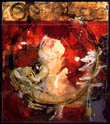
Blood Cenote
Mixed media on board.
Geiser, himself, works in a shaman's studio, surrounded by the ceremonial masks and totems familiar to the trade. Emblematic circles of gold are strong signifiers in past and present images. In the nooks and corners of the studio stand earlier works: paintings of large and darkly brooding fossilized shapes, obscure references to primal creatures; elegiac reminders of previous investigations.
The bones and ashes of these primal images lie buried beneath the surface of his latest work -- big, exuberant explorations of the nature of paint, rich and juicy, oozing onto a color field of royal blue, or spilling over gobs of sandstone laced with crimson. So metabolic and tactile is his mix of organic materials (such as dirt and clay with rhoplex and pigment), that Geiser could easily be dismissed as a sensualist were it not for the informed intelligence that breathes life into these lush compositions.
In "Blood Cenote," for instance, the familiar motifs of circles and grid, the crimson and gold are embedded references to ancient sites, sacred and secular, and to myths half remembered within the universal psyche. Cenote refers to an ancient Mexican method of water collection: a large basin carved out of rock that because of its very necessity transforms itself into a sacred site as well. The metaphors start to flow and the entire painting is an evocation of human upheaval: of change and transformation.
For Geiser is, above all, a painter's painter, consumed and obsessed with the mystery of paint and its evocation of a state of being: tactile, emotional, and intelligent reference to the universe. At his best, he balances precariously between a sensual outpouring of gestural heroics and the stoic underpinnings of grid and informed composition. Whatever metaphors or paradigms we impose on this work, its potency lies in Geiser's ability to understand and emphatically communicate the essential nature of art-making: its mutable sensibilities; the risky balance between thought and gesture.
Shown recently at the Kim Foster Gallery in Soho, an exhibit of his recent paintings moves on to the Butters Gallery in Portland, Oregon in June.
-Kay Kenny
Cover Magazine
April 1998